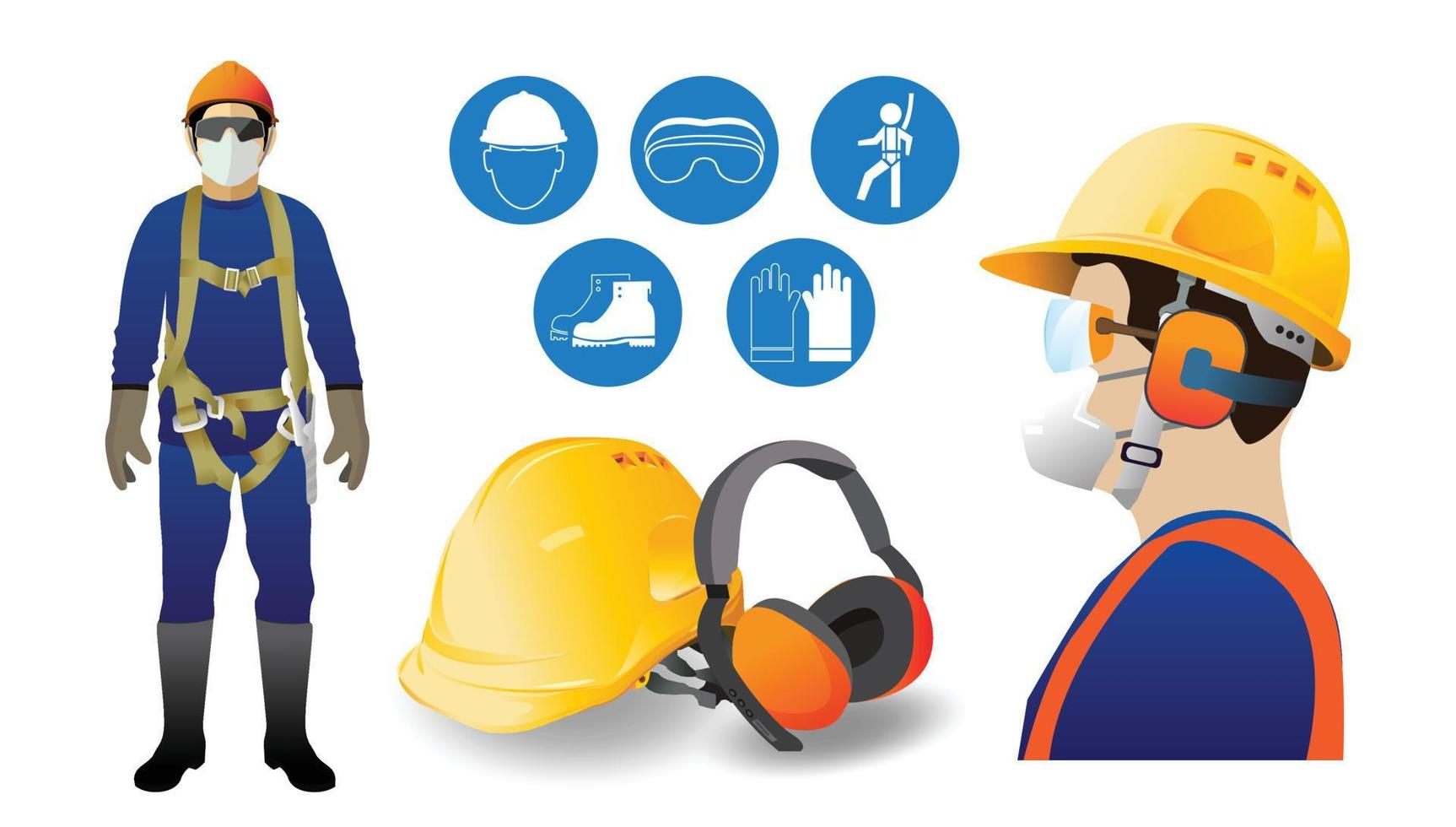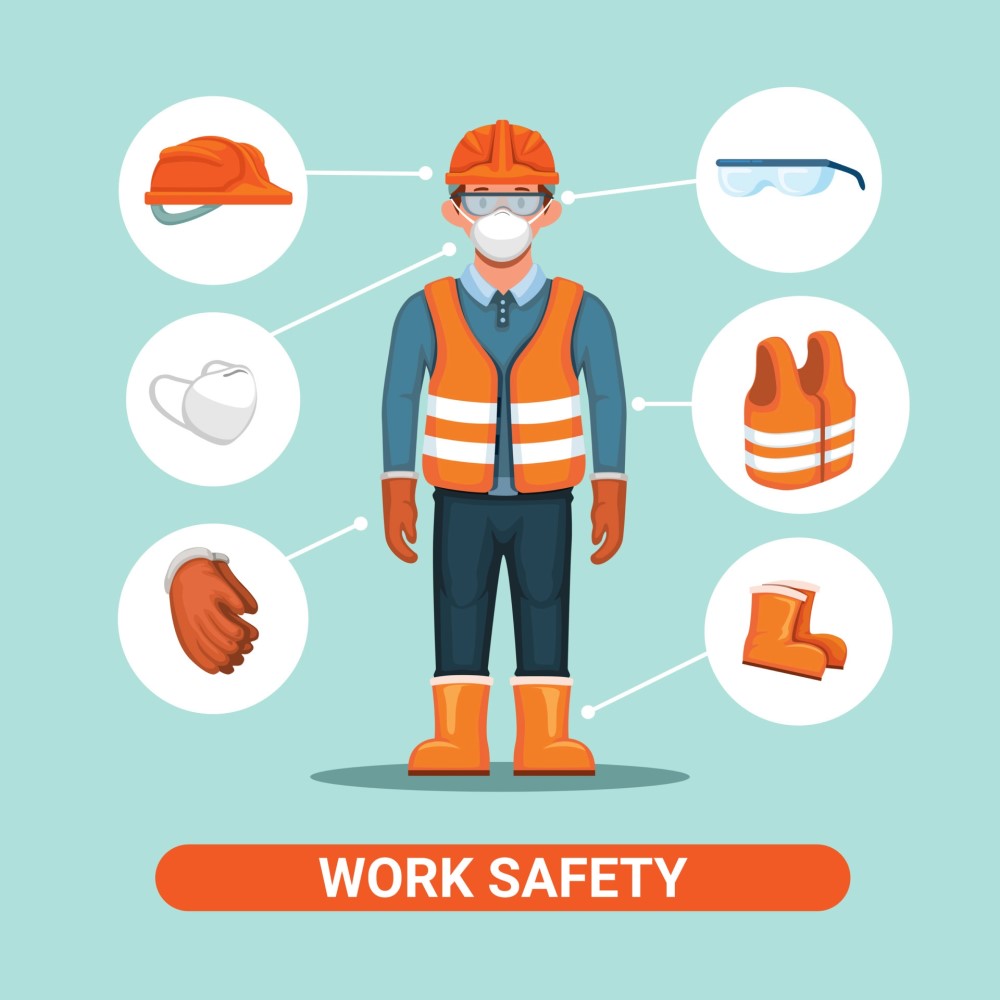Employer-provided clothes and personal safety gear must be used according to employee training. Before they start a certain task, they should be informed of the reasons why the usage of personal safety equipment is required. In this article, guardboots will provide a personal safety equipment list so you know what to pack before you enter the construction site.
Employers are required to provide personal safety equipment when workplace dangers cannot be removed or minimized by other risk control techniques. Employers must make sure that the products they buy adhere to applicable requirements.
Personal safety equipment needs to be kept secure, easily accessible, clean, and completely functional. In order to make sure that devices are in good functioning order, they must be inspected frequently and before use. Any errors that are discovered must be notified right away to reduce any potential dangers.
Personal safety equipment list

1. Safety Eyewear
Several contracting operations put workers’ eyes at risk. Therefore, there is a chance of harm if they are not properly shielded by safety glasses. Dust, debris, chemicals in the air, and powerful impacts can all cause eye injuries in construction workers. Wearing goggles thereby immediately aids in preventing visual deterioration. It is on the personal safety equipment list for the same reasons.
In some workplaces, safety goggles are essential to shield workers’ eyes from flying debris, hot liquids, molten metal, toxic fumes, and dangerous radiation. This PPE must be able to be cleaned, snugly and pleasantly fit the user’s face, and not obstruct vision or movement. Safety goggles, safety glasses, and welding shields are all examples of protective eyewear.
2. Earplugs and Earmuffs
According to the personal safety list, earplugs and earmuffs are essential. They are intended to safeguard workers against exposure to extreme noise, which can result in permanent hearing loss and raised stress levels. As you are aware, working close to noisy heavy equipment can have an adverse effect.
Employees should be provided with specially designed earmuffs in environments where noise levels are frequently high. The shorter the period of time a person may operate without proper hearing protection, the louder and more constant the noise. Long-term hearing loss can affect even workers.
3. Surgical Face Masks
The lips and nose of the user are covered by a disposable, form-fitting surgical face mask, which forms a physical barrier between them and those nearby. The purpose of this safety personal equipment is to shield the user from minute particles or big splashes that can contain germs as well as lessen the amount of saliva and respiratory secretions that the user spreads to others.
4. Face Shields
The visor is made up of a visor, a thin metal or plastic frame, and an attachment mechanism that secures it to the wearer’s head. This personal safety gear is typically worn over a mask or pair of goggles for full face protection to stop inhalation of potentially dangerous materials or, as in the case of COVID-19, virus-carrying aerosol droplets. To lower the risk of purchasing fake products, employers who are sourcing personal safety equipment for their staff must carefully investigate and assess potential vendors.
5. Respirators
The air at construction sites is frequently contaminated and unsafe to breathe. It’s impossible to keep track of all the construction-related dust, carbon monoxide, fumes, or harmful gas emissions. Workers will likely have respiratory issues and perhaps fatal infections if their protection is inadequate.
Filtering facepiece respirators and powered air-purifying respirators are the 2 types of respirators that are utilized with reusable respirators. Organizations may utilize one of them, depending on the particulars of the construction sites.
6. Hard Helmets
Hard helmets are an essential piece of protective equipment when you visit a construction site. They are crucial in protecting employees from major head trauma, concussions, and spine and bone fractures. Because many statistics show that the construction industry has the highest rate of traumatic brain injury of all occupations. And the level of danger to life is about the same.
It is safe to state that concussions occur frequently at work and that if there were no hard helmets to cushion the impact, brain injuries would likely increase. It is essential that you give your construction employees high-quality hard hats. When it comes to the personal safety equipment list, we cannot ignore hard helmets because we know how important they are.
7. Safety Gloves
As you know, if you have a hand injury, you can’t do anything at the construction site. As an employee, you need your hands most of all and you should be concerned about protecting them from the adverse effects of the work environment. For example, when you move a rock, your hands are in direct contact and the frictional effects cause your hands to wear and fray. Even if there is an accident, the fingers can bleed or bruise.
Safety gloves are crucial since construction involves a lot of hard labor and workers’ hands. Naturally, contractors handle a variety of dangerous and abrasive materials that call for careful handling. Different site operations demand specific safety gloves that must meet very high criteria.
8. Safety Shoes
If workers are not equipped with sufficient foot protection, there are various hazards at a construction site that can result in catastrophic injuries. To protect workers’ feet from accidents brought on by sloppy footing or other causes, foot protection is a crucial component of the personal safety equipment list.
Transporting large items, including construction materials, is prone to accidents where workers’ feet are struck. They have plates on their shoes to protect them from harm should they fall. Conversely, slips and falls frequently happen on construction sites where there are unsafe working conditions, which is why the soles of workers’ shoes are also designed with an anti-slip grip. It’s significant to mention that the rubber sole protects workers from floor electric shock as well.
9. High-Visibility Vests
High-visibility vests are one of the must-have personal safety devices when you move around the construction site. One great use of them is their very high visibility which helps you get noticed when you need help or they also protect you in some other dangerous situations. Additionally, the visibility jacket has a fluorescent material on its exterior, which is particularly helpful at night.
You are aware that maintenance work on bridges, highways, and inland traffic are all a part of construction activity. A contractor might be hit and killed in an accident if a car is driving toward a building site and the driver cannot see you because you are too small or dim. However, while wearing high visibility jackets, contractors are seen even when working at night.
10. Body Shields
Workers may need to wear full body protection in situations that are especially risky. Clothes, aprons, lab coats, overalls, and jumpsuits are all examples of body protection. They are made of a variety of materials, such as rubber, leather, plastic, and wool or cotton that is resistant to fire. To guarantee a perfect fit, body guards of this kind must be meticulously sized for each employee. Because of the above, body shields are obviously on our personal safety equipment list.

Conclusion
Personal safety equipment are personal wearable devices that protect workers from serious workplace injuries. Injuries and illnesses can result from exposure to chemicals, radiation, electrical, mechanical, physical, or workplace hazards.
Personal safety equipment list may include items such as safety glasses, ear plugs or earmuffs, respirator, hard hat, gloves and safety shoes. Besides it can also be overalls, jackets and other special equipment depending on the environment and work of each worker.
Learn more: 3 Basic Types of the Personal Protective Equipment

